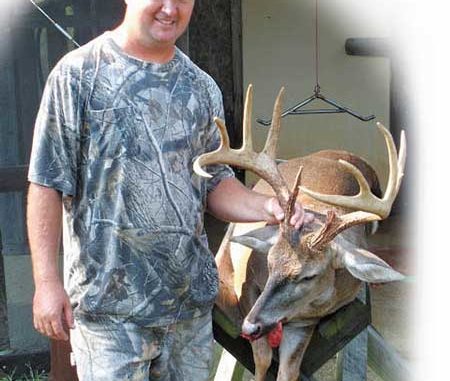
This Williamsburg County hunter dropped a huge buck in a cornfield.
Deep within the agricultural-rich Lowcountry of South Carolina, another trophy buck has bitten the dust.
It took Edward Strong of Suttons only 20 minutes on the morning of Sept. 7 to bag a 10-point brute on hunt-club land near his Williamsburg County home.
The buck weighed 207 pounds, was estimated at 4½ to 5½ years old, and carried an 18½-inch wide rack that scored 145 Boone & Crockett Club points.
And the buck wasn’t necessarily a surprise to Strong, who had been seeing nice deer on trail cameras all over the hunt-club property. He killed the buck on the edge of a corn field flanked by mature hardwoods. The field borders and adjacent woods were covered with pre-rut sign, including large rubs and an occasional scrape. The field itself looked like Grand Central Station, with hundreds of heavy-footed tracks coming and going.
Strong erected a 14-foot Big Game double-seat ladder stand on the edge of the field a few weeks before the season arrived, overlooking the heaviest trails coming into the field.
A heating/air conditioning contractor, Strong’s work schedule didn’t allow him to hunt whenever he wished. He did slip into the stand in the middle of one week, shortly after gun season opened.
As he slipped down the edge of the field just before the crack of dawn, he could barely make out a large-racked buck working the edge right in front of his stand. The buck was completely out of range, and in an effort not to spook the deer, Strong hunkered down and waited for the deer to slip into the edge of the woods to give him just enough time to continue to the ladder stand, hoping the buck would re-emerge after he got in the stand.
Despite waiting a long time that morning, Strong left for work, the buck never coming back. That left him itching to get back in the stand, the thought of big antlers on his mind all the time. But several days passed before he could get back for a weekend hunt.
On Sunday morning, Sept. 7, Strong eased back to the ladder stand and settled in at 6:20, just before daybreak, hoping for a second look — and second chance — at the buck.
“Just as light began to illuminate the field enough for me to see, I caught movement on the trail where the big buck had left the field, but it was just a doe,” Strong said. “Exactly two minutes later, big boy stepped out on the way to the doe feeding in the corn.
“There was no question (that) he was big enough, so I quickly took aim with my .270 Browning A-Bolt and fired a round off into his vitals.”
The buck ran 20 feet into the field and collapsed.
“I couldn’t help myself but to slide down the stand and sprint through the cornfield to where my big buck was laying,” Strong said.
The buck was plenty big enough to cause any hunter to break into a sprint. It carried a heavy, 10-point rack with a broken brown tine and one sticker point. The longest tines were 8½ inches, and the buck had circumference measurements of 4½ inches well out on the main beam.
Strong feels like the buck, his biggest in 20 years of hunting in Williamsburg County, was the result of some strict management his hunt club has been doing for the past eight years on its 1,200 acres.
In fact, except for shooting does, Strong’s season was over when he pulled the trigger; club members can take only one buck per season.
“The single buck affords strict attention to detail and surety before ever pulling the trigger,” said Strong, who agrees that the single most-limiting factor in growing trophy bucks is age, with good genetics and adequate nutrition following closely behind.
The club has dedicated portions of agricultural fields and has created numerous food plots deep within the forest, specifically planted for deer and turkeys. Soybeans and corn are planted during the early summer, followed by a supplemental planting of peas late in the summer along field edges and within the woods.
By the first of October, all of the food plots and field edges are planted in naked oats.
“The naked oats really reels them in just after they break the surface of the ground,” Strong said. “Deer absolutely love them. Naked oats have a high nutritional punch in a smaller package.”





Be the first to comment